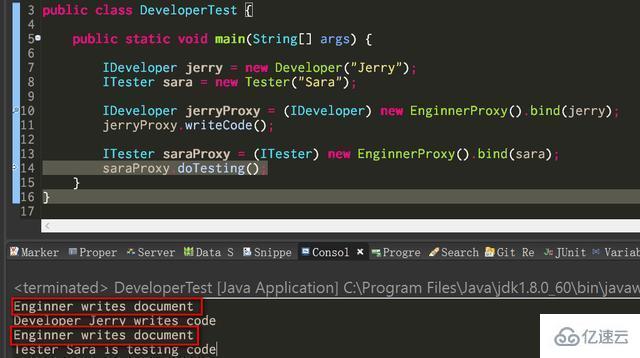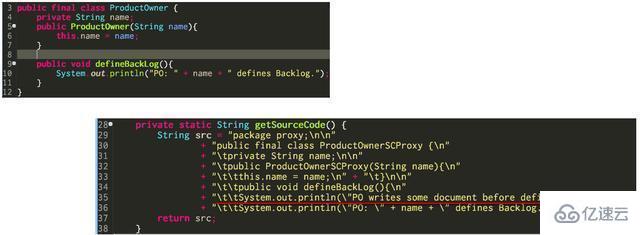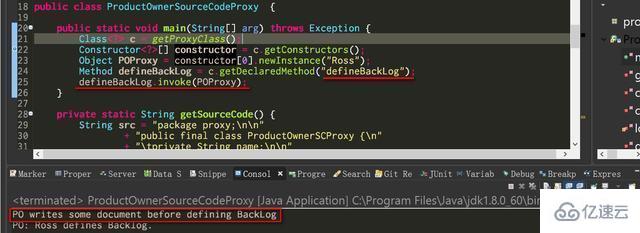您好,登錄后才能下訂單哦!
您好,登錄后才能下訂單哦!
這篇文章將為大家詳細講解有關Java中靜態代理和動態代理有哪四種方法實現,文章內容質量較高,因此小編分享給大家做個參考,希望大家閱讀完這篇文章后對相關知識有一定的了解。
面試問題:Java里的代理設計模式(Proxy Design Pattern)一共有幾種實現方式?這個題目很像孔乙己問“茴香豆的茴字有哪幾種寫法?”
所謂代理模式,是指客戶端(Client)并不直接調用實際的對象(下圖右下角的RealSubject),而是通過調用代理(Proxy),來間接的調用實際的對象。
代理模式的使用場合,一般是由于客戶端不想直接訪問實際對象,或者訪問實際的對象存在技術上的障礙,因而通過代理對象作為橋梁,來完成間接訪問。

實現方式一:靜態代理
開發一個接口IDeveloper,該接口包含一個方法writeCode,寫代碼。
public interface IDeveloper {
public void writeCode();
}創建一個Developer類,實現該接口。
public class Developer implements IDeveloper{
private String name;
public Developer(String name){
this.name = name;
}
@Override
public void writeCode() {
System.out.println("Developer " + name + " writes code");
}
}測試代碼:創建一個Developer實例,名叫Jerry,去寫代碼!
public class DeveloperTest {
public static void main(String[] args) {
IDeveloper jerry = new Developer("Jerry");
jerry.writeCode();
}
}現在問題來了。Jerry的項目經理對Jerry光寫代碼,而不維護任何的文檔很不滿。假設哪天Jerry休假去了,其他的程序員來接替Jerry的工作,對著陌生的代碼一臉問號。經全組討論決定,每個開發人員寫代碼時,必須同步更新文檔。
為了強迫每個程序員在開發時記著寫文檔,而又不影響大家寫代碼這個動作本身, 我們不修改原來的Developer類,而是創建了一個新的類,同樣實現IDeveloper接口。這個新類DeveloperProxy內部維護了一個成員變量,指向原始的IDeveloper實例:
public class DeveloperProxy implements IDeveloper{
private IDeveloper developer;
public DeveloperProxy(IDeveloper developer){
this.developer = developer;
}
@Override
public void writeCode() {
System.out.println("Write documentation...");
this.developer.writeCode();
}
}這個代理類實現的writeCode方法里,在調用實際程序員writeCode方法之前,加上一個寫文檔的調用,這樣就確保了程序員寫代碼時都伴隨著文檔更新。
測試代碼:

靜態代理方式的優點
1. 易于理解和實現
2. 代理類和真實類的關系是編譯期靜態決定的,和下文馬上要介紹的動態代理比較起來,執行時沒有任何額外開銷。
靜態代理方式的缺點
每一個真實類都需要一個創建新的代理類。還是以上述文檔更新為例,假設老板對測試工程師也提出了新的要求,讓測試工程師每次測出bug時,也要及時更新對應的測試文檔。那么采用靜態代理的方式,測試工程師的實現類ITester也得創建一個對應的ITesterProxy類。
public interface ITester {
public void doTesting();
}
Original tester implementation class:
public class Tester implements ITester {
private String name;
public Tester(String name){
this.name = name;
}
@Override
public void doTesting() {
System.out.println("Tester " + name + " is testing code");
}
}
public class TesterProxy implements ITester{
private ITester tester;
public TesterProxy(ITester tester){
this.tester = tester;
}
@Override
public void doTesting() {
System.out.println("Tester is preparing test documentation...");
tester.doTesting();
}
}正是因為有了靜態代碼方式的這個缺點,才誕生了Java的動態代理實現方式。
Java動態代理實現方式一:InvocationHandler
InvocationHandler的原理我曾經專門寫文章介紹過:Java動態代理之InvocationHandler最簡單的入門教程
通過InvocationHandler, 我可以用一個EnginnerProxy代理類來同時代理Developer和Tester的行為。
public class EnginnerProxy implements InvocationHandler {
Object obj;
public Object bind(Object obj)
{
this.obj = obj;
return Proxy.newProxyInstance(obj.getClass().getClassLoader(), obj
.getClass().getInterfaces(), this);
}
@Override
public Object invoke(Object proxy, Method method, Object[] args)
throws Throwable
{
System.out.println("Enginner writes document");
Object res = method.invoke(obj, args);
return res;
}
}真實類的writeCode和doTesting方法在動態代理類里通過反射的方式進行執行。
測試輸出:

通過InvocationHandler實現動態代理的局限性
假設有個產品經理類(ProductOwner) 沒有實現任何接口。
public class ProductOwner {
private String name;
public ProductOwner(String name){
this.name = name;
}
public void defineBackLog(){
System.out.println("PO: " + name + " defines Backlog.");
}
}我們仍然采取EnginnerProxy代理類去代理它,編譯時不會出錯。運行時會發生什么事?
ProductOwner po = new ProductOwner("Ross");
ProductOwner poProxy = (ProductOwner) new EnginnerProxy().bind(po);
poProxy.defineBackLog();運行時報錯。所以局限性就是:如果被代理的類未實現任何接口,那么不能采用通過InvocationHandler動態代理的方式去代理它的行為。

Java動態代理實現方式二:CGLIB
CGLIB是一個Java字節碼生成庫,提供了易用的API對Java字節碼進行創建和修改。關于這個開源庫的更多細節,請移步至CGLIB在github上的倉庫:https://github.com/cglib/cglib
我們現在嘗試用CGLIB來代理之前采用InvocationHandler沒有成功代理的ProductOwner類(該類未實現任何接口)。
現在我改為使用CGLIB API來創建代理類:
public class EnginnerCGLibProxy {
Object obj;
public Object bind(final Object target)
{
this.obj = target;
Enhancer enhancer = new Enhancer();
enhancer.setSuperclass(obj.getClass());
enhancer.setCallback(new MethodInterceptor() {
@Override
public Object intercept(Object obj, Method method, Object[] args,
MethodProxy proxy) throws Throwable
{
System.out.println("Enginner 2 writes document");
Object res = method.invoke(target, args);
return res;
}
}
);
return enhancer.create();
}
}測試代碼:
ProductOwner ross = new ProductOwner("Ross");
ProductOwner rossProxy = (ProductOwner) new EnginnerCGLibProxy().bind(ross);
rossProxy.defineBackLog();盡管ProductOwner未實現任何代碼,但它也成功被代理了:

用CGLIB實現Java動態代理的局限性
如果我們了解了CGLIB創建代理類的原理,那么其局限性也就一目了然。我們現在做個實驗,將ProductOwner類加上final修飾符,使其不可被繼承:

再次執行測試代碼,這次就報錯了: Cannot subclass final class XXXX。
所以通過CGLIB成功創建的動態代理,實際是被代理類的一個子類。那么如果被代理類被標記成final,也就無法通過CGLIB去創建動態代理。
Java動態代理實現方式三:通過編譯期提供的API動態創建代理類
假設我們確實需要給一個既是final,又未實現任何接口的ProductOwner類創建動態代碼。除了InvocationHandler和CGLIB外,我們還有最后一招:
我直接把一個代理類的源代碼用字符串拼出來,然后基于這個字符串調用JDK的Compiler(編譯期)API,動態的創建一個新的.java文件,然后動態編譯這個.java文件,這樣也能得到一個新的代理類。

測試成功:

我拼好了代碼類的源代碼,動態創建了代理類的.java文件,能夠在Eclipse里打開這個用代碼創建的.java文件,


下圖是如何動態創建ProductPwnerSCProxy.java文件:

下圖是如何用JavaCompiler API動態編譯前一步動態創建出的.java文件,生成.class文件:

下圖是如何用類加載器加載編譯好的.class文件到內存:

關于Java中靜態代理和動態代理有哪四種方法實現就分享到這里了,希望以上內容可以對大家有一定的幫助,可以學到更多知識。如果覺得文章不錯,可以把它分享出去讓更多的人看到。
免責聲明:本站發布的內容(圖片、視頻和文字)以原創、轉載和分享為主,文章觀點不代表本網站立場,如果涉及侵權請聯系站長郵箱:is@yisu.com進行舉報,并提供相關證據,一經查實,將立刻刪除涉嫌侵權內容。